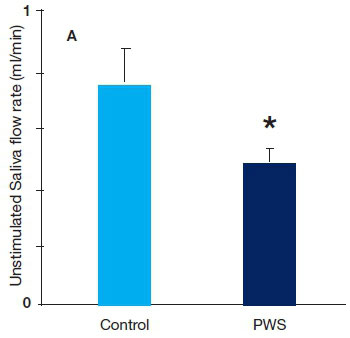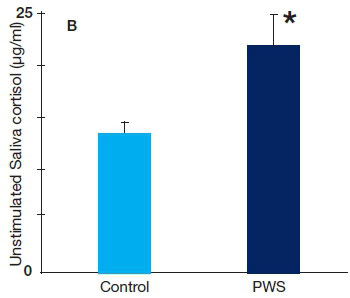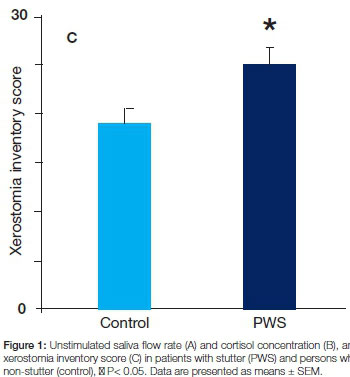Serviços Personalizados
Artigo
Indicadores
Links relacionados
-
 Citado por Google
Citado por Google -
 Similares em Google
Similares em Google
Compartilhar
South African Dental Journal
versão On-line ISSN 0375-1562
versão impressa ISSN 0011-8516
S. Afr. dent. j. vol.71 no.4 Johannesburg Mai. 2016
RESEARCH
Salivary cortisol level and severity of xerostomia in patients who stutter
Behnoosh Vasaghi-GharamalekiI; Iraj Mirzaii-DizgahII; Zohreh Arani-KashaniIII
IRehabilitation Research Centre, Department of Basic Sciences of Rehabilitation, Rehabilitation Sciences School, Iran University of Medical Sciences, Tehran, Iran
IIDepartment of Physiology, School of Medicine, Aja University of Medical Sciences, Tehran, Iran
IIIRehabilitation Research Centre, Department of Basic Sciences of Rehabilitation, Rehabilitation Sciences School, Iran University of Medical Sciences, Tehran, Iran
ABSTRACT
BACKGROUND: Stuttering is associated with high levels of anxiety. Salivary cortisol is used as a biomarker to assess stress level. Dry mouth is one of the symptoms of anxiety. The aim of this study was to evaluate salivary cortisol levels and severity of xerostomia in men with and without stuttering.
METHODS: In a case-control study, 19 patients with stuttering (PWS) and 19 control individuals were recruited to the investigation. The xerostomia inventory (XI) score was used as an index of the severity of xerostomia. The salivary cortisol concentration was measured by an enzyme immunoassay kit (ELISA). Student's t-test was used in the statistical analysis.
RESULTS: The mean unstimulated saliva flow rate was lower (P=0.045), and the mean unstimulated saliva concentration of cortisol (P=0.017) and XI score (P= 0.044) were significantly higher in the PWS than in control individuals.
CONCLUSION: It can be concluded that saliva levels of cortisol and severity of xerostomia are high in stutterers and these patients suffer xerostomia.
Keywords: Cortisol, Saliva, Xerostomia, Stutter
INTRODUCTION
Stuttering is defined as a disturbance in the rhythm of speech (fluency disorder). The patients with stuttering (PWS) know what they want to say but often are unable to put the words together. They suffer from involuntary disruptions of speech, including syllable repetitions, prolongations, blocking of sounds, substitutions, as well as involuntary pauses. Given the involuntary nature of stuttering and the fact that it is socially evident, the affliction has a potentially negative impact on mental and emotional health and quality of life of the patient.1,2 Consequently, stuttering is associated with high levels of social anxiety.3 PWS expect to experience speech difficulties in many social situations, based on associated previous negative experiences, resulting in anxiety. In addition, anxiety leads to psychophysiological and autonomic reactions follow such as a freezing response, the fight or flight response or the alarm or stress response.3,4 Typical physiological changes occur in anxiety states such as increased heart rate, elevated pulse volume, enhanced tonic and phasic skin conductance, a galvanic skin response, or the stimulation of production of different hormones like catecholamine, adrenocorticotropin, cortisol, prolactin, and thyroxin.5 Physiological and psychological responses to stress are mediated by the hypothalamic-pituitary-adrenal (HPA) axis, the sympathoadrenal system, and brain monoaminergic systems such as locus coeruleus (noradrenalin production).
Cortisol is released after stressful emotional situations and has effects on energy level, learning, memory, neural plasticity, immunity and on behaviour such as sleep patterns, mood and the reception of sensory input.6,7 Salivary cortisol measurements provide a reliable indicator of the functional status of the hypothalamus-hypophysis-adrenal axis and has been used in studies on stress evaluation, depression, and anxiety.7,8 Saliva secretion is essential for the health of oral cavity tissues and has been used as a non-invasive source for medical investigations. Whilst cortisol levels may be assessed in serum, the measurement in saliva offers several advantages, such as being stress-free, painless, non-invasive, allowing for frequent and rapid sampling in different situations, with no need for trained staff.9-12 It has been shown that cortisol injected intravenously appears in saliva within less than a minute and reaches a peak concentration within 2-3 minutes while at the same time similar concentrations are achieved in the plasma.7
Anxiety is one of the causes of a feeling of a dry mouth. Dehydration and a lack of oral lubrication impacts on functions, and sufferers of dry mouth encounter difficulties with speaking, eating and swallowing.13 Although there are some reports of cortisol levels being raised with selected stressors, research on salivary cortisol from PWS are rare and obscure. These patients suffer stress and anxiety coupled with reduced salivary flow. This study undertook measurements of salivary cortisol and salivary flow rates in an Iranian male cohort of stutterers.
METHODS AND MATERIALS
Subjects
The Ethics Committee of Tehran University of Medical Sciences (TUMS), Iran, approved the study protocol (1708742). Informed consent was obtained from all participants.
A total of 38 men were asked to participate in a case/control study. Nineteen patients with stuttering (PWS), with ages 32.2 ± 5.9 years, were recruited from amongst the patients attending the laboratory of physiology of the Rehabilitation Science School, TUMS. A matched sample of 19 individuals with no documented stuttering (aged 36.2 ± 7.3 years) were included as controls. Smokers, obese patients (body mass index ≥ 30 kg/m2), patients taking xerogenic medical agents, patients with certain systemic diseases (including patients with diabetes, Sjogren's syndrome, etc.), oral candidiasis or unfavourable oral health conditions such as poor oral hygiene and periodontal diseases (pocket depth more than 3 mm) and patients who used antidepressant or antianxiety drugs were excluded.
All subjects completed questionnaires about the status of their xerostomia (Table 1). A Xerostomia inventory (XI) score was then determined as the severity of dry mouth feeling (xerostomia) for each subject. The scores of these responses were added to the questionnaire score, to provide a Total XI score for each individual (the minimum possible score was 11 and the maximum possible score was 55).14-16

Sample collection
Unstimulated whole saliva was collected under resting conditions in a quiet room between 8:30 am and 10:30 am and at least 90 min after the last intake of food or drink. The duration of saliva sample collecting was recorded with a stopwatch. At the start, the participants were asked to swallow any saliva pooled in their mouths, after which unstimulated whole saliva was collected from the individuals by having them expectorate their fresh saliva, into dry, de-ionized, sterile plastic tubes, this process being timed and the volume being recorded. The salivary flow rate was calculated by dividing the volume of saliva by the duration of saliva sample collection. The samples were clarified by centrifugation (2500g, 10 minutes), and immediately stored at −20ºC for later determination of cortisol.
Cortisol Assays
The salivary cortisol concentration was analyzed by ELISA technology using commercially available kits (DRG Instruments GmbH, Mar Burg, Germany).
Statistical Analysis
For statistical analysis, the data are presented as a mean ± standard error of mean (SEM). The two-tailed Student's unpaired t-test was used to compare saliva cortisol levels between experimental and control groups. P < 0.05 was considered statistically significant.
RESULTS
Student's t-test showed that there was a significant drop (p<0.05) in mean unstimulated saliva flow rate in the PWS group compared with the control (Figure 1A). The concentration of cortisol was significantly higher in the mean unstimulated saliva of the PWS group (p<0.05) (Figure 1B).
The Xerostomia inventory score, an index of xerostomia severity, was significantly higher [p<0.05. Student-t], in the PWS sample than in the controls (Figure 1C)
DISCUSSION
High levels of anxiety may be experienced by people who stutter, resulting in a dry mouth and raised levels of salivary cortisol, a biomarker used to assess stress level. This study has shown a significantly higher cortisol concentration in unstimulated saliva and a severity of xerostomia which is also significantly higher [p<0.05 Student-t] in PWS than in control individuals. Salivary flow rates were found to be significantly lower in the PWS group.
Bio-behavioural research uses salivary levels of cortisol as a reliable non-invasive technique for measuring the concentration of this hormone, producing a consistent, comparable measure which accords with levels of free cortisol in plasma.6,17,18 Public speaking increases salivary cortisol in men and, considering the results of this study, it is evident that the levels of this hormone are also higher in PWS.19 A previous study based on samples of 11 PWS and 11 controls and testing low and high levels of stress found that there was no significant difference in salivary cortisol hormone between the two low stress groups.5,19,20 (Days without any stress were considered as low stress, and for those days when routine tasks were not right or "everything was going wrong", these dysfunctional days were considered as high stress.). Saliva had been collected in that study between 3:30 pm and 6:00 pm when cortisol levels are low. To better highlight demonstrable variations in salivary cortisol output, it is advisable to collect saliva in the morning, when blood cortisol levels are high.5 A subsequent study based on morning sampling found that cortisol levels were higher with stress than without stress.20 However, the results showed no significant difference between PWS and controls after laboratory stress, even though cortisol levels increased.19
The current study reflects data procured in mid-morning in a relaxed environment for all volunteers, allowing ameliorated adaptation (Figures 1A, 1B and 1C). Essentially the research evaluated the resting levels of cortisol in PWS and in a control group and found significantly raised levels in the PWS group which also experienced relatively severe levels of xerostomia. The research focus group was well matched with the controls relative to age, gender, socio-economic status, cultural and geographic concordance. Hence it is clear that even in a non-stressed situation, the PWS have higher levels of the stress hormone, cortisol.
Statements of PWS and review of psychophysiological studies indicate that anxiety levels amongst PWS are related to speaking situations such as talking on the telephone, talking with people, or introducing themselves.1,4 Conversely, observing and listening to stuttered speech has been shown to induce physiological and emotional reactions in listeners.21 Further research is needed to evaluate the effects of viewing and experiencing stuttered speech on salivary cortisol levels.
The Saliva flow index is a parameter which may be used for classification of saliva flow as normal, low, or very low. In adults, unstimulated saliva flow is considered as low if it ranges between 0.1 and 0.25 mL/min and if it is less than 0.1 mL/min then the flow is considered very low or as hyposalivation.22 One of the side effects of drugs which are used in the treatment of stuttering (such as paroxetine or sertraline) is dry mouth.23 In this study, patients who had used drugs for at least two months prior to sampling were excluded. However, unstimulated saliva flow rate was less than 0.1 mL/min in none of control and case groups; but it was significantly higher [p<0.05 Student-t] in control group than amongst the PWS. In addition, this study showed that xerostomia inventory score was significantly high in PWS. It showed dry mouth or xerostomia is a subjective issue, characterized by an unpleasant feeling in the mouth and throat, and does not necessarily relate to hyposalivation in up to one third of cases.15,25
CONCLUSION
The present study shows salivary levels of cortisol and severity of xerostomia are higher and the saliva flow rate is lower in Iranian male PWS, when compared with non-stutterers. This implies PWS have a more marked stress reaction than non-PWS. The stutterers had higher subjective feelings of dry mouth. Accordingly, it is suggested further research be conducted with larger research cohorts, to not only assess stress hormonal output and fluctuations of saliva in PWS , but also the effect their speech may have on other aspects of metabolism, the quality of life of PWS 's and the possible effects upon their social contacts.
Acknowledgement
We would like to thank all volunteers for their helpful participation. The Rehabilitation Research Center of Tehran University of Medical Sciences provided financial support for this project.
ACRONYMS
HPA: hypothalamic-pituitary-adrenal
PWS: patients with stuttering
TUMS: Tehran University of Medical Sciences
XI: xerostomia inventory score
References
1. Craig A and Tran Y. Fear of speaking: chronic anxiety and stammering. Adv In Psychiatric Treat 2006; 12:63-68. [ Links ]
2. Craig A, Blumgart E, Tran Y. The impact of stuttering on the quality of life in adults who stutter. J Fluency Disord 2009; 34(2):61-71. [ Links ]
3. Alm PA: Stuttering, emotions, and heart rate during anticipatory anxiety: a critical review. J Fluency Disord 2004; 29(2):123-33. [ Links ]
4. Menzies RG, O'Brian S, Onslow M, Packman A, St Clare T, Block S: An experimental clinical trial of a cognitive-behavior therapy package for chronic stuttering. J Speech Lang Hear Res 2008; 51(6):1451-64. [ Links ]
5. Blood GW, Blood IM, Bennett S, Simpson KC, Susman EJ: Subjective anxiety measurements and cortisol responses in adults who stutter. J Speech Hear Res 1994; 37(4):760-8. [ Links ]
6. Levine A, Zagoory-Sharon O, Feldman R, Lewis JG, Weller A: Measuring cortisol in human psychobiological studies. Physiol Behav 2007; 90(1):43-53. [ Links ]
7. Kirschbaum C, Hellhammer DH: Salivary cortisol. Encyclopedia Stress 2000; 3:379-83. [ Links ]
8. Hellhammer DH, Wüst S, Kudielka BM: Salivary cortisol as a biomarker in stress research. Psychoneuroendocrinology 2009; 34(2):163-71. [ Links ]
9. Dickerson SS, Kemeny ME: Acute stressors and cortisol responses: a theoretical integration and synthesis of laboratory research. Psychol Bull 2004; 130(3):355-91. [ Links ]
10. Agha-Hosseini F, Mirzaii-Dizgah I, Mansourian A, Khayamzadeh M: Relationship of stimulated saliva 17 beta-estradiol and oral dryness feeling in menopause. Maturitas 2009; 62(2):197-9. [ Links ]
11. Agha-Hosseini F, Mirzaii-Dizgah I, Mansourian A, Zabihi-Akhtechi G: Serum and stimulated whole saliva parathyroid hormone in menopausal women with oral dry feeling. Oral Surg Oral Med Oral Pathol Oral Radiol Endod 2009; 107(6):806-10. [ Links ]
12. Mirzaii-Dizgah I, Agha-Hosseini F: Stimulated and unstimulated saliva progesterone in menopausal women with oral dryness feeling. Clin Oral Investig 2011; 15(6):859-62. [ Links ]
13. Mathison R: Submandibular salivary gland endocrine secretions and systemic pathophysiological responses. The Open Inflammation J 2009; 2: 9-21. [ Links ]
14. Fox PC, Busch KA, Baum BJ: Subjective reports of xerostomia and objective measures of salivary gland performance. J Am Dent Assoc 1987; 115(4):581-4. [ Links ]
15. Agha-Hosseini F, Mirzaii-Dizgah I, Moghaddam PP, Akrad ZT: Stimulated whole salivary flow rate and composition in menopausal women with oral dryness feeling. Oral Dis 2007; 13(3):320-3. [ Links ]
16. Agha-Hosseini F, Mirzaii-Dizgah I, Moosavi MS: Relationship of serum and saliva calcium, phosphorus and alkaline phosphatase with dry mouth feeling in menopause. Gerodontology 2012; 29(2):e1092-7. [ Links ]
17. Agha-Hosseini F, Mirzaii-Dizgah I, Mirjalili N: Relationship of stimulated whole saliva cortisol level with the severity of a feeling of dry mouth in menopausal women. Gerodontology 2012; 29(1):43-7. [ Links ]
18. Agha-Hosseini F, Mirzaii-Dizgah I, Mirjalili N: Relationship of unstimulated whole saliva cortisol level with severity of oral dryness feeling in menopausal women. Aust Dent J 2011; 56: 171-4. [ Links ]
19. Kirschbaum C, Wüst S, Hellhammer D: Consistent sex differences in cortisol responses to psychological stress. Psychosom Med. 1992;54(6):648-57. [ Links ]
20. Blood GW, Blood IM, Frederick SB, Wertz HA, Simpson KC: Cortisol responses in adults who stutter: coping preferences and apprehension about communication. Percept Mot Skills 1997; 84(3 Pt 1):883-9. [ Links ]
21. Guntupalli VK, Everhart DE, Kalinowski J, Nanjundeswaran C, Saltuklaroglu T: Emotional and physiological responses of fluent listeners while watching the speech of adults who stutter. Int J Lang Commun Disord 2007; 42(2):113-29. [ Links ]
22. Humphrey SP, Williamson RT: A review of saliva: normal composition, flow, and function. J Prosthet Dent 2001; 85(2):162-9. [ Links ]
23. Costa D, Kroll R: Stuttering: an update for physicians. CMAJ 2000; 162(13):1849-55. [ Links ]
24. Shigeyama C, Ansai T, Awano S, Soh I, Yoshida A, Hamasaki T, Kakinoki Y, Tominaga K, Takahashi T, Takehara T: Salivary levels of cortisol and chromogranin A in patients with dry mouth compared with age-matched controls. Oral Surg Oral Med Oral Pathol Oral Radiol Endod 2008; 106(6):833-9. [ Links ]
 Correspondence:
Correspondence:
Iraj Mirzaii-Dizgah
Department of Physiology, School of Medicine
Aja University of Medical Sciences
Tehran, Iran
Tel/Fax: +98 21 88337921
E-mail: emirzaii@alumnus.tums.ac.ir
















